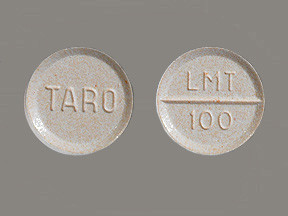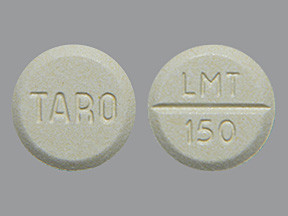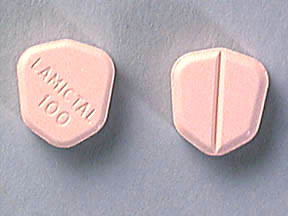LAMOTRIGINE - ORAL
PHONETIC PRONUNCIATION: (lam-OH-try-jeen)
COMMON BRAND NAME(S): Lamictal
GENERIC NAME(S): lamotrigine
Uses
USES: Lamotrigine is used alone or with other medications to prevent and control seizures. It may also be used to help prevent the extreme mood swings of bipolar disorder in adults. Lamotrigine is known as an anticonvulsant or antiepileptic drug. It is thought to work by restoring the balance of certain natural substances in the brain. This drug is not approved for use in children younger than 2 years due to an increased risk of side effects (such as infections).
How to use LAMOTRIGINE - ORAL
HOW TO USE: Read the Medication Guide and, if available, the Patient Information Leaflet provided by your pharmacist before you start taking lamotrigine and each time you get a refill. If you have any questions, ask your doctor or pharmacist. Take this medication by mouth with or without food as directed by your doctor. Swallow the tablets whole since chewing them may leave a bitter taste. Dosage is based on your medical condition, response to treatment, and use of certain interacting drugs. (See also Drug Interactions section.) For children, the dosage is also based on weight. It is very important to follow your doctor's dosing instructions exactly. The dose must be increased slowly. It may take several weeks or months to reach the best dose for you and to get the full benefit from this medication. Take this medication regularly in order to get the most benefit from it. To help you remember, take it at the same time(s) each day. Do not stop taking this medication without consulting your doctor. Some conditions may become worse when the drug is suddenly stopped. Your dose may need to be gradually decreased. Also, if you have stopped taking this medication, do not restart lamotrigine without consulting your doctor. Tell your doctor if your condition does not improve or if it worsens.
Side Effects
Precautions
Interactions
Overdose
Images

- color
- light peach
- shape
- round
- imprint
- TARO, LMT 100

- color
- light blue
- shape
- round
- imprint
- TARO, LMT 200

- color
- light yellow
- shape
- round
- imprint
- RDY, 22 1
Reviews
Faq for LAMOTRIGINE - ORAL
Lamotrigine is used to treat epilepsy and bipolar disorder.
Lamotrigine works by stabilizing electrical activity in the brain and decreasing abnormal brain activity that causes seizures or mood swings.
Common side effects of lamotrigine include dizziness, headache, nausea, blurred vision, and skin rash.
Lamotrigine may be used during pregnancy if the benefit outweighs the potential risks. It is important to discuss with a healthcare provider before using this medication during pregnancy.
Lamotrigine should be taken exactly as prescribed by a healthcare provider. It is usually taken once or twice a day with or without food. The dosage may need to be adjusted gradually to achieve the optimal effect.
Lamotrigine can interact with certain medications such as valproic acid and hormonal birth control. It is important to inform a healthcare provider about all medications being taken to avoid potential interactions.
The effects of lamotrigine may not be immediate. It can take several weeks or longer to reach its full effect. It is important to continue taking the medication as prescribed even if there are no immediate improvements.
Lamotrigine has a rare but serious side effect of causing a severe skin reaction. It is important to seek immediate medical attention if a rash develops while taking this medication.
Lamotrigine should not be abruptly discontinued, as it may increase the risk of seizures. A healthcare provider should be consulted for guidance on gradually reducing the dosage if the medication needs to be stopped.
Warning
WARNING: Rarely, serious (sometimes fatal) skin rashes have occurred while taking this medication. These rashes are more common in children than in adults. Rashes may be more likely if you start at too high a dose, if you increase your dose too quickly, or if you take this medication with certain other anti-seizure medications (valproic acid, divalproex). These rashes may occur anytime during use, but most serious rashes have occurred within 2 to 8 weeks of starting lamotrigine. Get medical help right away if you develop any type of skin rash, or if you have other signs of a serious allergic reaction such as hives, fever, swollen lymph nodes, painful sores in the mouth or around the eyes, swelling of the face/tongue/throat, trouble breathing, or liver problems (symptoms include stomach/abdominal pain, nausea/vomiting that continues, dark urine, yellowing eyes/skin). Your doctor will tell you if you should stop taking lamotrigine. Even after you stop taking this, it is still possible for a rash to become life-threatening or cause permanent scars or other problems.
Disclaimer
IMPORTANT: HOW TO USE THIS INFORMATION: This is a summary and does NOT have all possible information about this product. This information does not assure that this product is safe, effective, or appropriate for you. This information is not individual medical advice and does not substitute for the advice of your health care professional. Always ask your health care professional for complete information about this product and your specific health needs.




No Reviews Yet